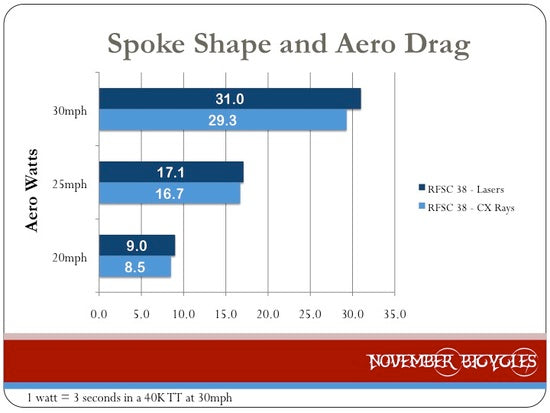One of the things we've learned is that offering choices invites questions. One we get all the time is the difference between Sapim Lasers and CX-Rays, which we offer in all our wheels. Or rather, the question really is whether CX-Rays are worth the extra money.
The answer we've always provided is that the spokes are the same weight but CX-Rays are purported to have some aerodynamic advantage. If you're looking for "every last watt of speed," they're the way to go. But we have never seen anything that quantifies the difference between the two in a wheelset. So we decided test Lasers against CX-Rays in the tunnel to give a more informed and specific response than "every last watt of speed."
It turns out, however, that we've been exactly right all along.
We sent two RFSC 38 (38mm) wheels to the wind tunnel, one built with 20 radial laced Sapim Lasers and the other with 20 radial laced Sapim CX-Rays. Here is how the wheels tested against a range of Angles of Attack (AOA):
At all AOAs, the wheel with the CX-Rays was a smidge faster, generating about 11 fewer grams of drag on average at 30mph. If you recall the calculations from yesterday's blog, you'll see that 11 grams of drag at 30mph is - yep - 1 aero watt. You really do save "every last watt of speed" with CX-Rays, and not a watt more.
You remember also from yesterday that aerodynamic impact is diminished at lower speeds. Here is the difference in aero watts between the Laser and CX-Ray wheels at 30mph, 25mph and 20mph. In these calculations, the average drag is calibarated by the frequency of different AOAs at different speeds, which is why at 30mph the difference between the two wheels is 1.8 watts instead of 1.
Most brands assume that if you're spending between $1K and $3K for a carbon wheelset, you're after that every last watt of speed and they make CX-Rays or other bladed spokes standard. The logic starts to break down with shallower alloys though, where the upgrade to CX-Ray spokes may net you a watt, but still leave you a handful or two behind your training buddy on deep carbon, or oblivious if you're training on your own. For alloys in particular, we think it makes a lot of sense to offer the choice so people are not paying for performance they don't need.



21 comments
Joe, a lot of people would see it differently, and that's why we gave people the choice. Choice sometimes equals inefficiency though, as it does in this case – we deal with 4 spokes per wheel (2 types, black and silver each) instead of just one. The Rail is going to be CX Ray only, which will enable some efficiency to that so the incremental cost of that watt will go down.You could also make the argument that as rims get more slippery, spokes represent a bigger portion of the drag and therefore reducing their drag becomes more important. Good discs are pretty darn fast. Say a disc saves 5 watts over a reasonably fast wheel when you test them alone, without the bike. Even if that savings is only 20% translated when the disc is acting as a rear wheel, if your job is to go fast in TTs, you use the disc. No question.
You can also make the argument that if there is less spoke length in a deeper rimmed wheel those spokes would be subject less wind.
Difference appears to be about 5% improvement with the CX Rays, regardless if the test speed was 20 MPH or 30 MPH. 25 MPH data only shows about a 2.5% improvement. Do you think this anomaly is real world or something that resulted from too many calculations being stretched too thin? Kudos on breaking the piggy bank and doing your own testing. Until you face that cold, hard data, you're just guessing!Andy
Andy – The raw drag data's pretty clean, and the only calculation is the drag at 30mph being scaled down to 25 and then 20.
Cxray' s are stronger than lasers + slightly more aero…. I always go for the stronger spokes… The aero was just a bonus.